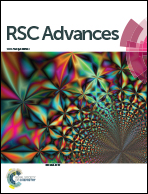A triple bond side-chained 2D-conjugated benzodithiophene based photovoltaic polymer†
Abstract
A series of triple bond side-chained benzodithiophene copolymers, derived from 4,8-bis(1-ethynyl-3,5-bis(octyloxy)phenyl)-benzo[1,2-b:4,5-b′]dithiophene, were synthesized by Stille coupling reactions. Several electron acceptors are introduced into the polymer backbone to tune the photo-electronic properties of the copolymers. The obtained copolymers are readily soluble in common organic solvents, such as toluene, THF and chloroform. The number average molecular weights of these polymers were determined by GPC using a polystyrene standard, ranging from 15 400 to 28 300 which are decent results for polymers with a rigid triple bond side chain. These polymers show high decomposition temperature (403–419 °C), narrow band gap (1.27–1.89 eV), and low-lying HOMO energy level (−5.4 to −5.6 eV). The best polymer solar cell (PSC) device based on the copolymer PBDTPA-TPD and PC61BM showed a power conversion efficiency (PCE) of 0.93% with a Voc = 0.96 V, Jsc = 1.9 mA cm−2, and FF = 51%, which is one of the highest Voc values achieved by a benzodithiophene polymer.


 Please wait while we load your content...
Please wait while we load your content...